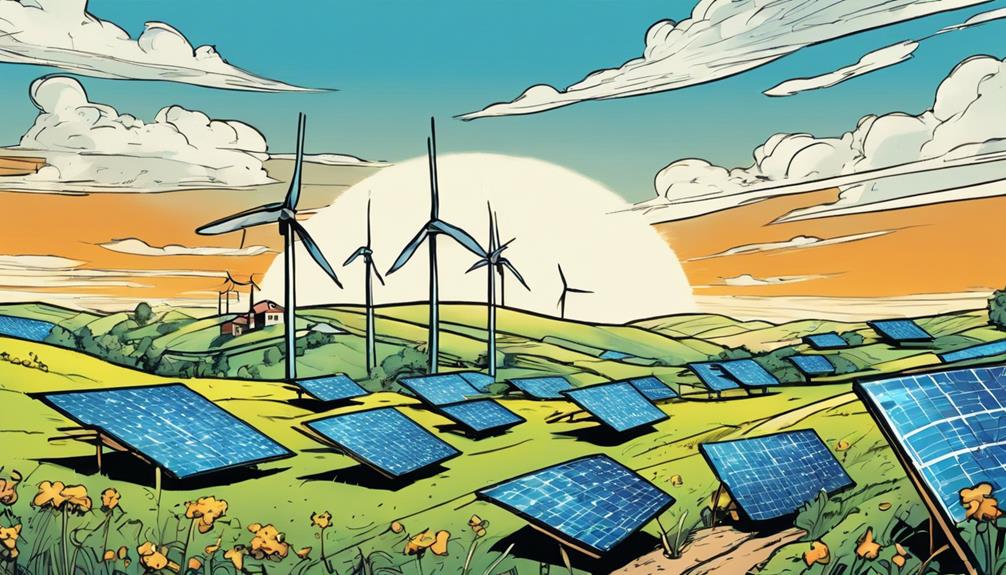As I explore the US energy landscape, I'm struck by the rapid rise of solar power. With over 2 million homes already harnessing its energy, it's clear this renewable source is revolutionizing the way we generate power. From reducing greenhouse gas emissions to creating jobs, the benefits are vast. While challenges like high upfront costs and intermittency remain, government support and technological advances are addressing these issues. As I look to the future, I'm excited to see how solar energy will continue to transform our energy landscape, making it cleaner, more sustainable, and more accessible to all. And there's more to this story…
Key Takeaways
- Over 2 million American homes use solar power, driving a significant shift towards renewable energy in the US residential sector.
- Solar energy accounts for a substantial portion of US electricity generation, reducing greenhouse gas emissions and combating climate change.
- Government support through tax credits and grants is vital in making solar energy more accessible and affordable to a wider range of individuals and communities.
- Rapid technological advancements in solar tech are overcoming current limitations, improving solar panel efficiency, and addressing energy storage and intermittency issues.
- Declining costs and increasing investments in solar energy are expected to play a significant role in achieving clean energy goals and reducing carbon emissions in the US.
Solar Energy Usage in the US

Over 2 million American homes have already chosen solar power, with solar panels being widely adopted in various sectors, including residential areas, commercial buildings, agricultural practices, public infrastructure, and educational institutions.
I'm excited to see the impact of solar energy across the country. California leads the way in solar energy capacity, followed closely by Texas, Florida, and North Carolina.
It's impressive to note that solar energy is utilized in multiple applications, including residential, commercial, industrial, and utility-scale projects. As I explore further, I realize that solar energy accounts for a significant portion of electricity generation in the US.
This widespread adoption is a sign of the growing demand for clean and sustainable energy solutions.
Benefits of Solar Energy Adoption

As I explore the benefits of solar energy adoption, I'm struck by the significant positive impact it has on both individuals and the environment. One of the most notable advantages is the reduction of greenhouse gas emissions, which combat climate change.
Solar power also creates jobs and stimulates economic growth in the renewable energy sector. Furthermore, solar panels increase property values and contribute to sustainable development in communities.
Additionally, solar energy provides reliable and affordable electricity, improving the quality of life for many. Overall, the shift to renewable energy has a profound impact on both individuals and the environment, making it an essential step towards a sustainable future.
Challenges in Solar Implementation

Despite the numerous benefits of solar energy, several challenges hinder its widespread implementation, including high initial expenses, sporadic power generation, and restricted storage capacities. As I explore the challenges, I realize that these obstacles can be significant barriers to adoption. For example, the initial setup costs for solar panels can be excessively costly for many consumers and businesses.
| Challenge | Impact |
|---|---|
| High Initial Expenses | Financial burden on consumers and businesses |
| Sporadic Power Generation | Unreliable energy supply due to weather conditions |
| Restricted Storage Capacities | Inability to store excess energy for later use |
These challenges underscore the need for innovative solutions and policy support to overcome these hurdles and make solar energy more accessible and reliable.
Government Support for Solar Energy

Government incentives, such as tax credits and grants, play an important role in mitigating the financial burden of solar energy adoption, making it more accessible to a broader range of individuals and communities. These financial supports have been instrumental in driving investment in solar energy projects, creating jobs, and reducing greenhouse gas emissions.
Favorable policies and incentives have accelerated the adoption of solar power, making it a more viable option for those looking to shift to renewable energy. As a result, government support has been vital in making solar energy more affordable and accessible to a wider range of individuals and communities.
Future of Solar Energy in the US

With increasing investments and policy support for renewable energy, I'm optimistic that solar energy will play a significant role in achieving clean energy goals and reducing carbon emissions in the US.
As technology advances, solar panels will become even more efficient, and energy storage capabilities will improve. I expect to see further declines in costs, making solar energy more accessible and affordable for individuals and communities.
The integration of solar energy with other renewable sources and storage technologies will create a more resilient energy system.
As research and development continue, I'm excited to see the innovative solutions that will emerge, driving the US towards a cleaner, more sustainable energy future.
Technological Advances in Solar Tech

As I look to the future of solar energy, I'm particularly excited about the rapid technological advancements being made in solar tech, which are poised to overcome many of the current limitations and take the industry to the next level.
Improvements in solar panel efficiency, for instance, are allowing for more energy to be generated from the same surface area. Advances in energy storage, such as batteries, are addressing the intermittency issue, ensuring a stable power supply.
Meanwhile, tracking systems and smart grid technologies are optimizing energy distribution and consumption. These breakthroughs will make solar energy more accessible, efficient, and cost-effective, driving its adoption further.
I'm thrilled to see how these innovations will reshape the US energy landscape.
Solar Energy's Economic Impact

I've witnessed firsthand how solar energy's economic impact is transforming communities across the US, from creating jobs and stimulating local economies to increasing property values and reducing energy costs for businesses and homeowners alike.
The solar industry is now a significant contributor to the country's GDP, with over 2 million residential properties already harnessing the power of the sun. As the demand for solar energy continues to grow, so do the economic benefits.
Not only does solar energy create jobs, but it also attracts new businesses and investments, further boosting local economies. In addition, solar panels increase property values, making neighborhoods more desirable and attractive to potential buyers.
Frequently Asked Questions
How Does Solar Energy Impact the National Grid's Overall Efficiency?
When I look at how solar energy impacts the national grid's overall efficiency, I see that it increases grid resilience by providing a decentralized, clean power source, reducing strain on traditional infrastructure during peak hours.
Can Solar Panels Be Used in Conjunction With Other Renewable Energy Sources?
"I think solar panels can definitely be used with other renewable energy sources. In fact, integrating solar with wind, hydro, and geothermal energy can create a more resilient and efficient energy system."
What Is the Average Lifespan of a Solar Panel Installation?
"As I ponder the future of solar energy, I realize that the average lifespan of a solar panel installation coincidentally aligns with my own long-term goals – a remarkable 25-30 years, ensuring a sustainable energy future."
How Do Solar Panels Perform in Extreme Weather Conditions?
I've wondered how solar panels hold up in extreme weather. Fortunately, they're designed to withstand harsh conditions like heavy rain, hail, and extreme temperatures, ensuring a reliable energy supply even in tough weather.
Can Solar Energy Be Used for Heating Water and Spaces?
Can I really rely on solar energy for more than just electricity? Yes, I can Solar energy can be used for heating water and spaces through solar thermal systems, providing a reliable and efficient alternative to traditional heating methods.
How Does Solar Power Revolutionize the Energy Landscape in Different Latitudes?
Solar energy is revolutionizing the energy landscape in different latitudes. In regions closer to the equator, solar panels can generate more energy due to the consistent sunlight. In contrast, at higher latitudes, solar panels may be less efficient but still contribute to sustainable energy production. Different latitudes and solar energy go hand in hand.
Conclusion
As I gaze out at the sea of solar panels blanketing the US landscape, I'm filled with a sense of hope and optimism. The sun's warm rays are igniting a revolution, powering homes, businesses, and communities while illuminating a path towards a cleaner, brighter future.
With each new installation, we're one step closer to breaking free from fossil fuels' grip, and embracing a tomorrow that's sustainable, prosperous, and radiant with possibility.










